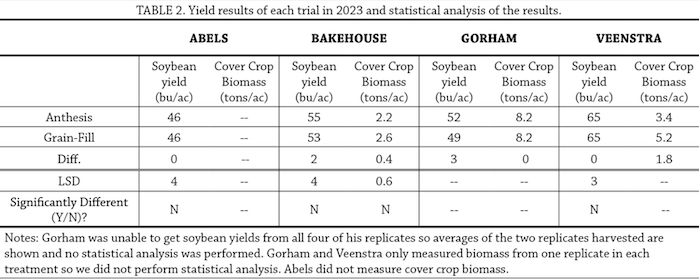In a Nutshell:
- Roll-crimping is a mechanical method for terminating cover crops that allows farmers to reduce tillage and herbicide use.
- Fred Abels, Jon Bakehouse, Keith Gorham and Kevin Veenstra investigated whether when they roll-crimp a rye cover crop (at Anthesis vs. at Grain-Filling) affected yield of soybeans no-till drilled into the rye cover crop prior to termination.
Key Findings:
- Abels, Gorham and Veenstra terminated rye in the Anthesis treatment an average of 14 days after soybean seeding and terminated rye in the Grain-Filling treatment an average of 27 days after soybean seeding. Bakehouse planted late and terminated his Anthesis treatment the day before seeding soybeans and the Grain-Filling treatment 19 days after seeding soybeans.
- None of the four cooperators found that roll-crimp timing (at rye anthesis vs. at grain-filling) significantly affected soybean yields in 2023.
- 2023 was a very dry spring at all four trial locations. Some cooperators were pleased that their results showed that they can roll-crimp at anthesis even in a dry year without a yield decline, while others wondered if their results might differ in a more average precipitation year.
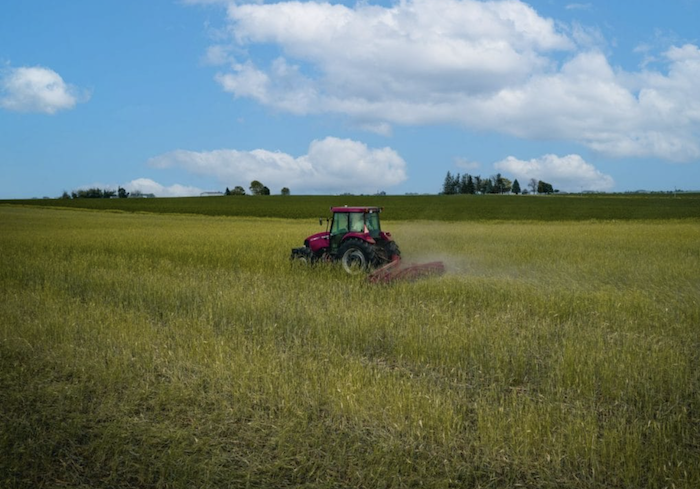
Fred Abels using his roller-crimper to terminate cereal rye at grain fill. Photo taken June 14, 2023 by Brady Appel.
Background
The roller-crimper is an implement developed by the Rodale Institute that flattens standing cover crop and crushes the stem, mechanically terminating it. The roller-crimper allows farmers to plant crops directly into a cover cropped field without using herbicide or tillage to terminate the cover crop. Many organic farmers wishing to reduce tillage while suppressing weeds rely on cover crops terminated using roller-crimpers. On conventional farms, roller-crimpers can also help reduce herbicide use, management time and costs while maintaining similar yields to chemical termination methods. PFI Cooperators have been conducting trials to explore how to make their roller-crimpers work well for them since 2017. This year, PFI members Fred Abels, Jon Bakehouse, Keith Gorham and Kevin Veenstra wanted to investigate the effect of roll-crimp timing on soybean yield in a system where soybeans are no-till drilled directly into a standing rye cover crop and the rye is terminated later in the season. This practice, commonly called planting green, gives the no-till soybeans an early start at growing while also allowing the cover crop to grow for a bit longer, maximizing biomass and subsequent weed suppression [10]. The cooperators chose to investigate the effect of two different roll-crimp timings (Anthesis vs. Grain-Filling) on soybean yield in this system. Past PFI research has shown that roll-crimping can be more effective at weed management when performed at Grain-Filling, but also that delaying rye termination by more than two weeks after soybean planting can decrease soybean yields [7], [9]. Abels summed up a common goal of the group well, saying “I want to make roll-crimping work for me and others to improve our bottom lines.”Methods
Design
Cooperators drilled one type of soybean at a single population into standing cereal and then subjected them to the following rye termination treatments:- Roll-crimp at Anthesis (flowering)
- Roll-crimp at Grain-Filling
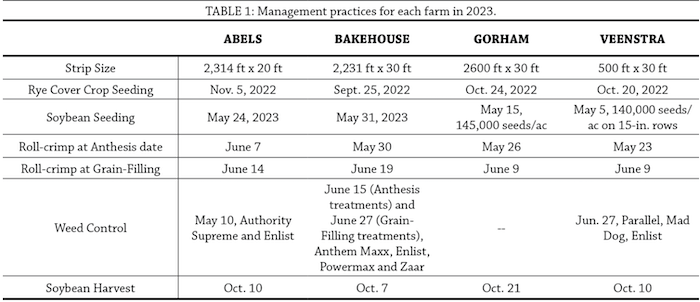

Keith Gorham’s planting setup for no-till soybeans. Photo taken May 15, 2023.
Measurements
Cooperators harvested cover crop biomass samples just prior to roll-crimping in both treatments. Cover crop biomass was air dried for 3 to 4 weeks and then weighed. Cooperators harvested soy from each strip and recorded yields and percent moisture. Yields were adjusted to 13% moisture.Data analysis
To evaluate effects of the roll-crimp termination treatments on soybean yield we calculated treatment averages for each measurement then used a t-test to determine if means differed significantly at the 95% confidence level. A significant difference would mean that the farmer can expect a difference in treatment to occur 95 out of 100 times under the same conditions. A not significant difference means that any observed difference in means is not statistically significant, and the treatment had no effect on yield. We could make these statistical calculations because each cooperator’s experimental design involved randomization and replication of the treatments (Figure A1).Results and Discussion

At left: Jon Bakehouse’s trial field a few days after roller crimping the Anthesis treatment but before soybeans have clearly emerged. Photo taken June 3rd, 2023; At right: Kevin Veenstra’s trial field after roller crimping. Soybeans have clearly emerged from the cereal rye mat. Photo taken June 26, 2023.
Conclusions and Next Steps
In this trial, cooperators found that roll-crimping at rye Anthesis vs. Grain-Filling did not significantly affect soybean yield or cover crop biomass. However, PFI cooperators will likely continue fine-tuning roll-crimp timing through future trials, determining over time how weather and field conditions might affect management decisions year-to-year. Bakehouse also is interested in trialing different varieties of rye to see if roll-crimping is more effective at termination on certain varieties.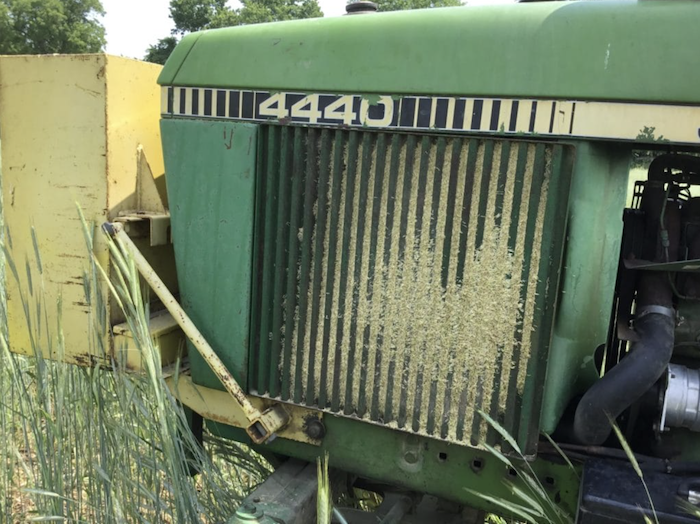
Anthers on Kevin Veenstra’s tractor after roller crimping rye. Photo taken June 9, 2023.

Figure A1. Example experimental design used by the cooperators.
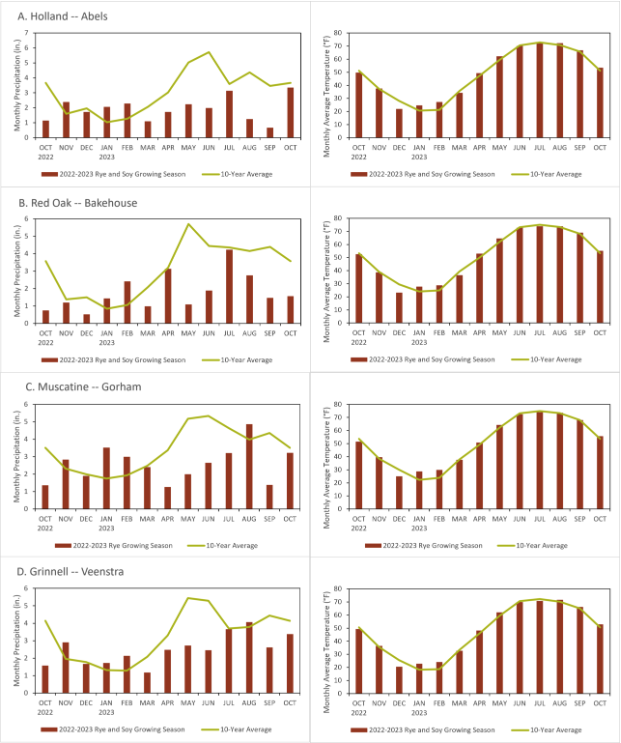
Figure A2. Weather in the 2022-2023 cereal rye and soybean growing season near each cooperator’s trial location. Monthly cumulative precipitation is shown in the left panels and monthly mean temperature is shown in the right panels for A) Holland, IA – Abels; B) Red Oak near Hastings, IA – Bakehouse; C) Muscatine near Illinois City – Gorham; and D) Grinnell, IA – Veenstra [11].
Funding Acknowledgements
This material is based upon work supported by the U.S. Department of Agriculture, under agreement number NR226114XXXXG004. Any opinions, findings, conclusions, or recommendations expressed in this publication are those of the author(s) and do not necessarily reflect the views of the U.S. Department of Agriculture. In addition, any reference to specific brands or types of products or services does not constitute or imply an endorsement by the U.S. Department of Agriculture for those products or services.References:
For full list of references used in this study, see references section:https://practicalfarmers.org/research/timing-of-roll-crimping-a-cereal-rye-cover-crop/Related Content:
[Video] No-Tillage Conference Sparked Idea for Steve Groff's Roller Crimper,
[Podcast] NCCS Preview: How to Turn Tillage Equipment into a Roller Crimper with Ryan Schmid,In-Row Roll-Crimping Cereal Rye Cover Crop Seeded in Twin-Rows Ahead of Soybeans
